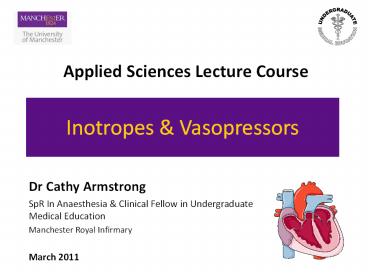Inotropes & Vasopressors - PowerPoint PPT Presentation
1 / 44
Title:
Inotropes & Vasopressors
Description:
Applied Sciences Lecture Course Inotropes & Vasopressors Dr Cathy Armstrong SpR In Anaesthesia & Clinical Fellow in Undergraduate Medical Education – PowerPoint PPT presentation
Number of Views:7092
Avg rating:3.0/5.0
Title: Inotropes & Vasopressors
1
Inotropes Vasopressors
Applied Sciences Lecture Course
- Dr Cathy Armstrong
- SpR In Anaesthesia Clinical Fellow in
Undergraduate Medical Education - Manchester Royal Infirmary
- March 2011
2
Objectives
- Define the terms Inotrope vasopressor
- Discuss basic physiological principles
- Discuss drug classification
- Sympathomimetics
- Other
- Describe some clinical uses
3
Inotropes Vs. Vasopressors
V
4
Inotropes
- Drugs that affect the force of contraction of
myocardial muscle - Positive or negative
- Term inotrope generally used to describe
positive effect
5
Vasopressor
- Drugs that stimulates smooth muscle contraction
of the capillaries arteries - Cause vasoconstriction a consequent rise in
blood pressure
6
Which of these drugs does NOT cause a positive
inotropic effect?
- Adrenaline
- Calcium
- Digoxin
- Enoximone
- Nifedipine
- Glucagon
7
Main Goal
Tissue perfusion oxygenation
8
Physiological Principles
MAP CO x SVR CO HR x SV
Preload Contractility Afterload
9
Basic principles - Vasopressors
MAP CO x SVR CO HR x SV
Preload Contractility Afterload
1
r4
10
Basic principles - Inotropes
MAP CO x SVR CO HR x SV
Preload Contractility Afterload
11
Mixed action drugs
12
Use of inotropes vasopressors
13
Drug Classification
- Sympathomimetics
- Naturally occurring
- Synthetic
- Other inotropes
- cAMP dependent
- cAMP independent
- Other vasopressors
14
Sympathomimetics
- Sympathetic nervous system
15
Sympathomimetics
- Drugs that stimulate adrenergic receptors
- G-protein coupled receptors
16
Which adrenoceptor mediates cardiac muscle
contraction?
- ?1
- ?2
- ?1
- ?2
17
Which adrenoceptor mediates vascular smooth
muscle contraction?
- ?1
- ?2
- ?1
- ?2
18
Main classes of Adrenoceptor
- ? receptors
- ?1
- Located in vascular smooth muscle
- Mediate vasoconstriction
- ?2
- Located throughout the CNS, platelets
- Mediate sedation, analgesia platelet aggregation
19
Main classes of Adrenoceptor
- ? receptors
- ?1
- Located in vascular smooth muscle
- Mediate vasoconstriction
- ?2
- Located throughout the CNS, platelets
- Mediate sedation, analgesia platelet aggregation
20
Main classes of Adrenoceptor
- ? receptors
- ?1
- Located in the heart
- Mediate increased contractility HR
- ?2
- Located mainly in the smooth muscle of bronchi
- Mediate bronchodilatation
21
Main classes of Adrenoceptor
- ? receptors
- ?1
- Located in the heart
- Mediate increased contractility HR
- ?2
- Located mainly in the smooth muscle of bronchi
- Mediate bronchodilatation
- Located in blood vessels
- Dilatation of coronary vessels
- Dilatation of arteries supplying skeletal muscle
22
ß1 Adrenoceptor
Adrenaline
Adenyl cyclase
G - Protein
Increased heart muscle contractility
cAMP
ATP
23
Sympathomimetics
- Naturally occuring
- Epinephrine
- Norepinephrine
- Dopamine
- Synthetic
- Dobutamine
- Dopexamine
- Phenylephrine
- Metaraminol
- Ephedrine
24
Sympathomimetics
- Naturally occuring
- Epinephrine
- Norepinephrine
- Dopamine
- Synthetic
- Dobutamine
- Dopexamine
- Phenylephrine
- Metaraminol
- Ephedrine
25
Epinephrine
- Stimulates ? ? receptors
- Predominantly ? effects at low doses and ?
effects at high doses - Clinical uses
- Cardiac arrest
- Anaphylaxis
- Low cardiac output states
- Upper airway obstruction
- Combination with local anaesthetics
26
Epinephrine
- Side effects
- Dysrhythmias
- Increase in myocardial oxygen consumption
27
Cardiac arrest
28
What is the dose of epinephrine administered
during cardiac arrest?
- 100mcg
- 1mg
- 10mg
- 100mg
- 1g
29
Anaphylaxis
30
What is the IM dose of epinephrine in anaphylaxis
- 100mcg
- 1mg
- 10mg
- 100mg
- 1g
31
1mg of epinephrine
- 1ml of 11000
- 10ml of 110,000
32
Norepinephrine
- Predominantly stimulates ?1 receptors
- Most commonly used vasopressor in critical care
- Very potent
- Administered by infusion into a central vein
- Uses
- Hypotension due to vasodilatation
- Septic shock
33
Dopamine
- Effect dose dependent
- Direct
- Low dose - ?1
- High dose - ?1
- Indirect
- Stimulates norepinephrine release
- D1 receptors
- Vasodilatation of mesenteric renal circulation
34
Dobutamine
- Synthetic
- Predominantly ?1
- Small effect at ?2
- Uses
- Low cardiac output states
- Cardiogenic shock
35
Sympathomimetics
- Naturally occuring
- Epinephrine
- Norepinephrine
- Dopamine
- Synthetic
- Dobutamine
- Dopexamine
- Phenylephrine
- Metaraminol
- Ephedrine
36
Adrenoceptor dynamics
- Desensitisation / down-regulation
- Chronic heart failure
- Prolonged use of inotrope / vasopressor
- Sespis / acidosis
37
Other inotropes
- cAMP dependent
- Phosphodiesterase inhibitors
- Glucagon
- cAMP independent
- Digoxin
- Calcium
- levosimendan
38
Phosphodiesterase inhibitors
- Non-selective
- Aminophylline
- Selective
- Phosphodiesterase 3
- Enoximone
- milrinone
39
Phosphodiesterase inhibitors
Adrenaline
Adenyl cyclase
G - Protein
Increased heart muscle contractility
ATP
cAMP
X
PDE 3
AMP
40
Digoxin
Inhibits (slows) NA/K ATPase
K
?K ?Na
NaK ATPase
Na
Na
Reduced Na gradient slows Ca removal
Na/Ca X-ch
Ca
41
Other vasopressors
- Vasopressin
- Exogenous form of ADH
- Acts on kidney to retain water on peripheral
blood vessels to cause intense vasoconstriction - V1 receptors
- Used in severe shock
- Used in cardiac arrest in USA
42
(No Transcript)
43
Summary
- Concept of inotropes vasopressors
- Physiological principles
- Categories
- Sympathomimetics
- cAMP dependent / independent inotropes
- Vasopressin
- Discussed clinical uses
All Figures were produced using Servier Medical
Art - www.servier.com
44
(No Transcript)

